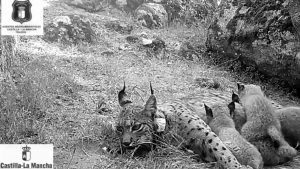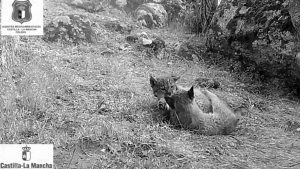This is the moment four cute endangered Iberian lynx kittens suckle from their mother and play around with each other as they frolic in the forest.
The heartwarming scenes were recorded in the Montes de Toledo mountains in central Spain after four Iberian lynx (Lynx pardinus) kittens were born, according to the councillor of Agriculture, Environment and Rural Development, Francisco Martinez Arroyo.
Video Credit: CEN
In the video, the four kittens can be seen playing next to their mother, named Nenufar, when she lies down and they begin suckling.
The four cute kittens can then be seen playing around with each other, jumping at each other and rolling around in the grass.

Arroyo wrote in social media: “With spring there are litters arriving which were born in freedom in Montes de Toledo.”
According to official sources, three female lynxes have been detected with cubs this year in the region of Castilla La Mancha, where the mountains are located.
This is Nenufar’s first litter after she was introduced into her natural habitat in 2017.
On 28th April 2016, scientists from the program Life Iberlince (a project for the recovery of the historic distribution of the Iberian lynx) and environmental officers from Castilla La Mancha located a litter of four lynxes, the first such litter detected in the area since the mid-1980s.
Since then, 83 of the endangered animals have been introduced into their natural environment in the areas of Sierra Morena Oriental (southern Spain) and Montes de Toledo with the help of Life Iberlince.

Thirteen lynxes have been introduced this year, with the final animal of the year set to be introduced on 9th May.
The Iberian lynx is listed as ‘endangered’ on the International Union for Conservation of NatureRed List.
By the turn of the 21st century, the Iberian lynx was on the verge of extinction, as only about 100 individuals survived in two isolated subpopulations in Andalusia.
Conservation efforts have helped boost the population in recent years.
To find out more about the author, editor or agency that supplied this story – please click below.
Story By: Ana Lacasa, Sub-Editor: Joseph Golder, Agency: Central European News




